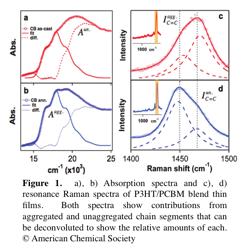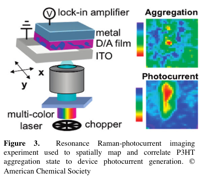AmericanChemicalSociety.com
Reports: DNI10 49008-DNI10: Uncovering and Understanding Morphology- Dependent Charge Transport and Trapping in Polymer Photovoltaic Materials
John K. Grey, University of New Mexico
This research used new resonance Raman spectroscopic imaging techniques to quantify and spatially map current-carrying and trapping sites in promising polymer composite solar cells. We chose polythiophene systems that exhibit remarkable ordering characteristics (i.e. aggregation) that are doped with fullerene derivatives to facilitate charge generation in solar cell devices. These composites are among the most promising systems for efficient light energy conversion although a number of fundamental issues are still unresolved related to their performance. For example, very little is understood about the role of local polymer chain packing and aggregation characteristics that can drastically alter charge transport properties.
We
next pursued combining our chemical imaging with approach to perform combined electrical
imaging studies in a functioning device structure. A major advantage of our approach over existing
scanned-probe techniques is that polymer properties can be studied in realistic
devices in a completely non-invasive fashion. In this experiment, the laser light was modulated using
either optical choppers or acoustic-optical modulators and focused to a
diffraction-limited spot inside a functioning P3HT/PCBM solar cell device. By using resonance excitation, the
photovoltaic cycle was initiated allowing for measurement of local
photocurrents using lock-in techniques while simultaneously measuring Raman
spectra. Fig. 2 shows a simple
schematic of the experiment along with representative Raman and photocurrent
images generated from a P3HT/PCBM solar cell device. This work demonstrated that highly aggregated polymer
regions actually contribute less to photocurrent generation
which shows that no fullerenes can fit between the highly ordered
polymer chains. An The
new insights afforded from these experiments were instrumental for the PI's recently successful NSF CAREER proposal
application. This research
also involved undergraduates (including two female students) who have appeared
on our publications.
 A
major finding of our research was that the polymer aggregation state could be
determined by decomposition of the dominant C=C symmetric stretching mode of
the backbone into contributions from both aggregated and unaggregated
species (see Fig. 1). By
changing processing conditions to optimize material performance, large changes
in this band are observed that were previously misinterpreted by several groups
as a gradual overall shift. We were able to reconcile previous observations
from both Raman and absorption spectroscopy of prototypical polythiophene/fullerene
(P3HT/PCBM) composites in terms of physically relevant electronic structure
models for aggregated organic systems.
Moreover, our imaging capabilities were leveraged to construct spatial
maps of aggregated species that revealed how important structural properties
varied within a realistic solar cell active layer. When thin films are annealed
by either solvent vapor or thermal treatments, polymer/fullerene components
phase segregate resulting in a complicated network of interpenetrating networks
of heterojunctions capable of separating charge from photogenerated excitons created
in the polymer component. Although
it has been recognized that local morphology and composition is vital for
determining the efficiency of this process, very little was actually understood
about the spatial locations of distinct phases. We have shown that in fullerene-rich regions that the
surrounding polymer is a highly crystalline (aggregated) whereas the
surroundings are loosely aggregated due to interspersed fullerene
molecules. These findings were not
expected from our initial hypothesis that the C=C mode would report on changes
in local electronic structure.
Instead, the processing-dependent changes observed could provide new
insights into the role of polymer structure (packing and crystallinity)
on device performance. This
initial work resulted in our first publication that appeared in the Journal of
the American Chemical Society and served as the basis for furthering our
understanding of structure-function relationships in novel polymer solar cell
materials.
A
major finding of our research was that the polymer aggregation state could be
determined by decomposition of the dominant C=C symmetric stretching mode of
the backbone into contributions from both aggregated and unaggregated
species (see Fig. 1). By
changing processing conditions to optimize material performance, large changes
in this band are observed that were previously misinterpreted by several groups
as a gradual overall shift. We were able to reconcile previous observations
from both Raman and absorption spectroscopy of prototypical polythiophene/fullerene
(P3HT/PCBM) composites in terms of physically relevant electronic structure
models for aggregated organic systems.
Moreover, our imaging capabilities were leveraged to construct spatial
maps of aggregated species that revealed how important structural properties
varied within a realistic solar cell active layer. When thin films are annealed
by either solvent vapor or thermal treatments, polymer/fullerene components
phase segregate resulting in a complicated network of interpenetrating networks
of heterojunctions capable of separating charge from photogenerated excitons created
in the polymer component. Although
it has been recognized that local morphology and composition is vital for
determining the efficiency of this process, very little was actually understood
about the spatial locations of distinct phases. We have shown that in fullerene-rich regions that the
surrounding polymer is a highly crystalline (aggregated) whereas the
surroundings are loosely aggregated due to interspersed fullerene
molecules. These findings were not
expected from our initial hypothesis that the C=C mode would report on changes
in local electronic structure.
Instead, the processing-dependent changes observed could provide new
insights into the role of polymer structure (packing and crystallinity)
on device performance. This
initial work resulted in our first publication that appeared in the Journal of
the American Chemical Society and served as the basis for furthering our
understanding of structure-function relationships in novel polymer solar cell
materials.
 alternative
explanation that we are presently pursuing is that these low energy regions may
instead be trapping charge. We
have begun voltage-dependent photocurrent imaging of these solar cells to
determine if in fact ordered
polymer regions are acting as charge sinks that may be of pivotal importance in
the selection of materials processing conditions to tune structure. This work appeared in the inaugural
issue of the Journal of Physical Chemistry Letters and, using the basic
platform of this new approach, we have developed a new frequency-dependent
current imaging technique that will allow us to image local displacement
currents in the device. In
addition, we have systematically perturbed the aggregation state of the polymer
that reveals a turnover in the regions where aggregated polymer chains usually
appear. The PI is currently
seeking additional funding from government agencies for these projects.
alternative
explanation that we are presently pursuing is that these low energy regions may
instead be trapping charge. We
have begun voltage-dependent photocurrent imaging of these solar cells to
determine if in fact ordered
polymer regions are acting as charge sinks that may be of pivotal importance in
the selection of materials processing conditions to tune structure. This work appeared in the inaugural
issue of the Journal of Physical Chemistry Letters and, using the basic
platform of this new approach, we have developed a new frequency-dependent
current imaging technique that will allow us to image local displacement
currents in the device. In
addition, we have systematically perturbed the aggregation state of the polymer
that reveals a turnover in the regions where aggregated polymer chains usually
appear. The PI is currently
seeking additional funding from government agencies for these projects.
Copyright © American Chemical Society

